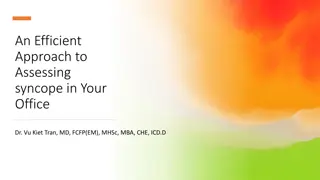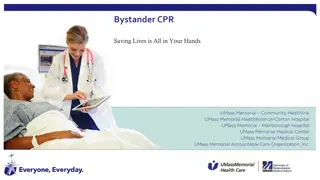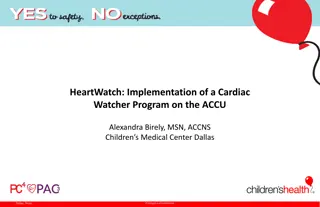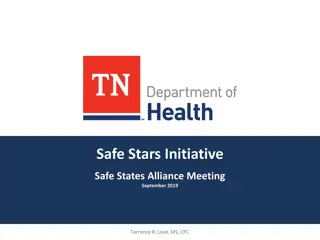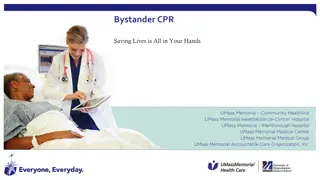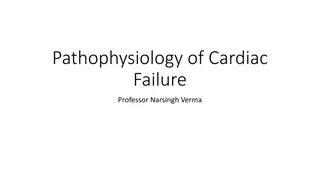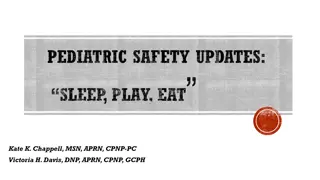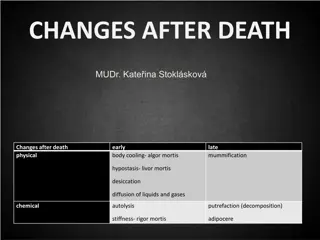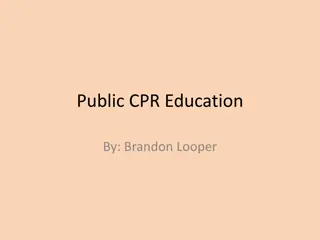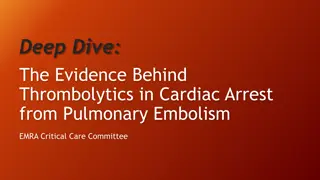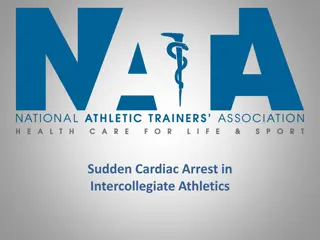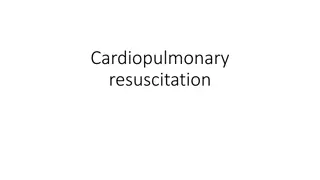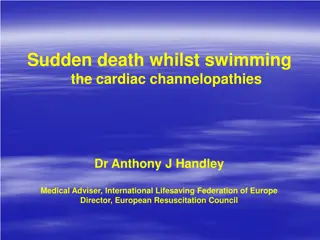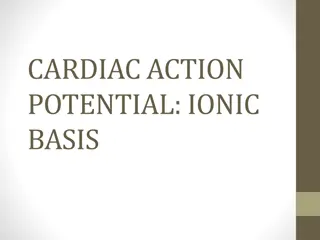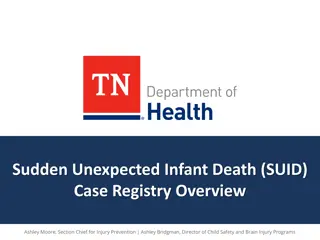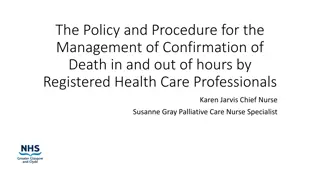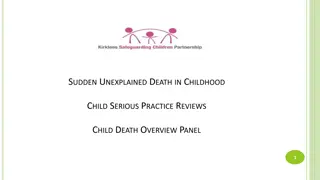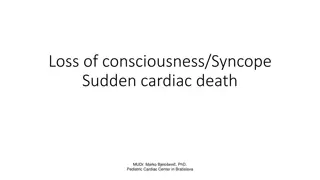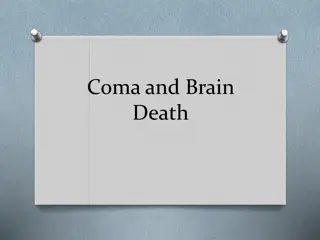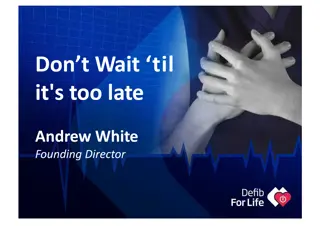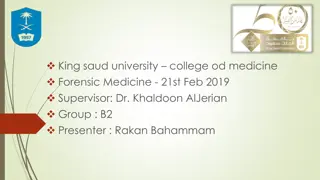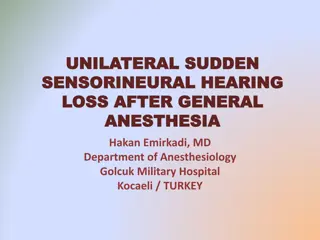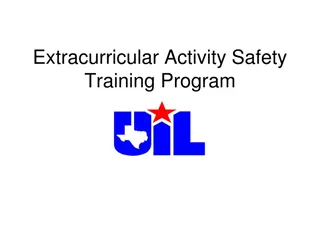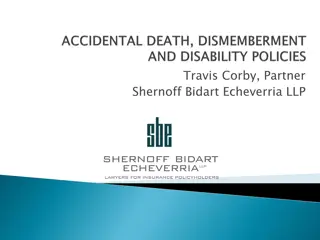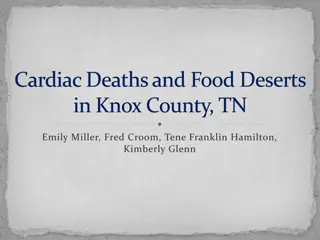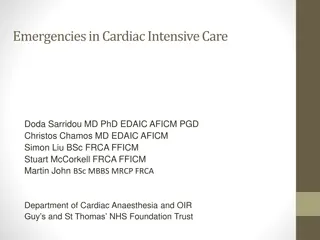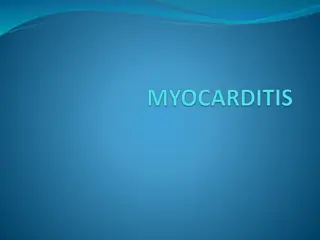Efficient Approach to Assessing Syncope in Office Practice
Dr. Vu Kiet Tran discusses an efficient approach to assessing syncope in office practice, focusing on risk factors for sudden cardiac death, the use of ECG and CT scans, and differential diagnosis to identify cardiac causes of syncope. Through case studies and learning objectives, key aspects of syn
4 views • 103 slides
Understanding Death and Dying in Human Life
Exploring the interdisciplinary field of thanatology, this chapter delves into the phases of transitioning from life to death, the definition of death in modern society, and how individuals of different ages perceive and cope with the concept of death. It discusses the importance of providing care a
1 views • 10 slides
Sudden Death and Cardiomyopathy Associated with LMNA in Nova Scotia Duck Tolling Retriever
A study on sudden death and cardiomyopathy in Nova Scotia Duck Tolling Retrievers due to LMNA association. The research includes genetic mapping, genotype verification, and functional predictions on Lamin A/C effects. Echocardiogram findings, pedigree data, genome-wide association study, whole-genom
0 views • 13 slides
Bystander CPR: Steps to Save Lives & Facts About Cardiac Arrest
Learn the importance of bystander CPR in saving lives during sudden cardiac arrest incidents. Understand the steps to perform hands-only CPR, identify compression rates, and the role of the Good Samaritan law. Discover key facts about sudden cardiac arrest and how bystander intervention can signific
1 views • 13 slides
Acoramidis Improves Cardiac Function in Transthyretin Amyloid Cardiomyopathy
Acoramidis, a next-generation TTR stabilizer, shows promising results in improving cardiac function and promoting regression in Transthyretin Amyloid Cardiomyopathy. The ATTRibute-CM Cardiac Magnetic Resonance Substudy evaluated changes in cardiac structure, function, and amyloid burden after treatm
0 views • 8 slides
Understanding Cardiac Output and Venous Return in Cardiovascular Physiology
Cardiac output, stroke volume, end-diastolic and end-systolic volumes play vital roles in cardiovascular function. Factors affecting cardiac output include physiological conditions and pathological states like hyperthyroidism and myocardial infarction. Venous return, controlled by mechanisms like Fr
0 views • 27 slides
Understanding Cardiac Electrical Activity in Physiology Team's Cardiovascular Block Lecture
Dive into the intricate details of cardiac electrical activity in this lecture led by Physiology Team 436. Explore topics like the cardiac conductive system, action potentials, refractory periods, excitation-contraction coupling, and the effects of autonomic stimulation on heart electrophysiology. D
0 views • 29 slides
Implementation of Cardiac Watcher Program in CMC Dallas
Twofold increase in sudden cardiac arrests on the ACCU prompted the implementation of the Cardiac Watcher Program in Children's Medical Center, Dallas. The program aims to decrease cardiac arrests by improving patient identification and creating a shared mental model among team members. Developed pa
0 views • 9 slides
Importance of Timely Verification in Care After Death
Understanding the verification process and importance of timely verification in care after death is crucial for improving the experience of death and dying for families. This session covers the definitions, process, and care after death, emphasizing the significance of timely verification in end-of-
1 views • 15 slides
Safe Stars Initiative - Promoting Safety in Youth Sports Organizations
The Safe Stars Initiative is a safety recognition program for youth sports organizations, aiming to standardize safety measures to protect young athletes. It offers Gold, Silver, or Bronze designations and addresses important injury topics like concussions, sudden cardiac arrest, emergency action pl
0 views • 25 slides
Bystander CPR: Steps to Save Lives During Cardiac Arrest
Learn how to perform hands-only CPR effectively in case of cardiac arrest. Understand the importance of quick action, proper compression rate, and the Good Samaritan law. Discover facts about sudden cardiac arrest and why bystander CPR can significantly increase survival rates. Follow a guide on wha
0 views • 13 slides
Association of Renal and Cerebral Near Infrared Spectroscopy with Low Cardiac Output in Single Ventricle Patients
Near-infrared spectroscopy (NIRS) has been studied in infants after Stage I palliation surgery to assess its association with low cardiac output and adverse outcomes. This retrospective study investigated postoperative cerebral and renal NIRS values in infants with single ventricle physiology. Resul
0 views • 13 slides
Understanding Cardiac Glycosides in Pharmacognosy and Phytochemistry
Explore the role of Steroids, Cardiac Glycosides, and Triterpenoids in pharmacognosy and phytochemistry, focusing on their general introduction, composition, chemistry, biosources, therapeutic uses, and commercial applications. Learn about the structure and attachment of sugar parts in Cardiac Glyco
9 views • 9 slides
Pathophysiology of Cardiac Failure and Adaptive Mechanisms of the Heart
Cardiac failure is a condition where the heart is unable to meet tissue metabolic needs despite normal or increased venous return. Causes include decreased contractility, coronary blood flow, damaged valves, and more. Normal resting cardiac output is 5 Lt/mts, with adaptive mechanisms like the Frank
0 views • 35 slides
Pediatric Safety Updates: Sleep-Related Infant Deaths Overview
Sleep-related infant deaths, including Sudden Infant Death Syndrome (SIDS) and accidental suffocation, remain a significant concern with over 3500 infant deaths in the US annually. Risk factors such as prone positioning, bed-sharing, premature birth, and maternal tobacco use contribute to these trag
1 views • 42 slides
Insights on Changes After Death and Definition of Death in Medical Science
Explore the physical changes that occur after death, such as body cooling, mummification, and putrefaction. Learn about the traditional and modern criteria for determining death, including somatic and brain death. Delve into the complexities of cellular death and the implications for organ transplan
1 views • 26 slides
Reflections on Death in John Donne's Poetry
John Donne's poem "Death, be not proud" challenges the conventional view of death as a fearsome force. The speaker addresses Death directly, asserting that it is not as mighty or dreadful as some believe. Instead, Death is portrayed as a servant to fate, chance, kings, and desperate men. The poem ex
0 views • 19 slides
Canadian Cardiac Transplant Network Status Review 2021
The Canadian Cardiac Transplant Network Status Review 2021 provides a detailed overview of cardiac transplant programs across various provinces in Canada from 2016 to 2021. The report includes data on the number of cases, hospitals involved, and referral centers, showcasing the trends in cardiac tra
1 views • 59 slides
Understanding Sudden Cardiac Arrest: Facts, Statistics, and Treatment
Sudden cardiac arrest is a critical condition where the heart suddenly stops beating, leading to a lack of blood flow to vital organs. Learn about the definition, statistics, importance of early CPR, and treatments for sudden cardiac arrest to increase survival rates. Bystander participation in perf
0 views • 13 slides
Thrombolytics in Cardiac Arrest from Pulmonary Embolism: Evidence Review
Thrombolytics are suggested for cardiac arrest from presumed PE despite lack of RCTs focusing on this subset. Studies on undifferentiated cardiac arrest did not show a survival benefit. Trials using tissue plasminogen activator in PEA arrest showed no significant difference in outcomes, while a stud
0 views • 13 slides
Understanding Sudden Cardiac Arrest (SCA) and AEDs
Sudden Cardiac Arrest (SCA) is a life-threatening condition where the heart suddenly stops beating, leading to death if not treated promptly. It can occur without warning signs and affects both children and adults. Automated External Defibrillators (AEDs) play a crucial role in providing immediate t
0 views • 10 slides
Sudden Cardiac Arrest in Intercollegiate Athletics: Are You Prepared?
Sudden Cardiac Arrest (SCA) is the leading cause of death in college athletes, emphasizing the importance of prevention and preparedness. Pre-participation evaluations, common causes of SCA, and emergency action plans are crucial in ensuring a timely response to SCA incidents, which may manifest in
0 views • 11 slides
Understanding Cardiopulmonary Resuscitation (CPR) and Cardiac Arrest
Cardiopulmonary resuscitation (CPR) is crucial in cases of cardiac arrest, a leading cause of death globally. Immediate recognition of symptoms such as unresponsiveness and abnormal breathing, early activation of emergency services, and prompt initiation of CPR can significantly improve survival rat
0 views • 23 slides
Understanding Sudden Death in Water: Insights and Implications
Explore the perplexing case of a drowning incident involving an 11-year-old swimmer, delving into the challenges of identifying the primary event leading to the tragedy. Discover the complexities of sudden cardiac death (SCD), autopsy findings, and potential causes of unexpected fatalities in aquati
0 views • 33 slides
Insights and Creativity: Exploring the Myth of Sudden Inspiration
Explore various instances of sudden insights throughout history, from Coleridge's Kubla Khan to Archimedes' Eureka moment. Delve into different perspectives on the nature of sudden insights, including divine inspiration, unconscious processes, and the role of business-like usual thinking in fosterin
0 views • 34 slides
Comprehensive Clinical Evaluation of Children with Cardiac Abnormalities
Initial clinical evaluation of a child with possible cardiac abnormalities includes history taking and physical examination. History should cover symptoms related to pulmonary and systemic venous congestion, cyanosis, cyanotic spells, palpitations, chest pain, and more. The general physical examinat
0 views • 65 slides
Understanding Cardiac Action Potential: Ionic Basis and Excitability in Cells
Explore the complex processes underlying cardiac action potential, from ionic equilibrium to resting membrane potential and excitability in cardiac cells. Learn about the critical thresholds, equilibrium potentials, and gradients that regulate the electrical activity of the heart. Discover the intri
0 views • 68 slides
Sudden Unexpected Infant Death Registry Overview
The Sudden Unexpected Infant Death (SUID) Case Registry provides insights into SUID cases, aiming to monitor trends, improve investigations, and implement prevention strategies. Led by experts Ashley Moore and Ashley Bridgman, the project is funded by the Centers for Disease Control and Prevention,
0 views • 16 slides
Policy and Procedure for Confirmation of Death by Health Care Professionals
In May 2017, a policy change led to allowing trained Healthcare Professionals to verify death in all situations. The Confirmation of Death (CoD) policy empowers Registered Health Care Professionals to confirm death, while medical staff handle the Medical Certification of Cause of Death (MCCD). The p
0 views • 13 slides
Understanding Sudden Unexpected Death in Childhood (SUDIC)
Sudden Unexpected Death in Childhood (SUDIC) refers to the sudden and unexplained death of a child, often referred to as Sudden Unexpected Death in Infancy (SUDI) or Sudden Infant Death Syndrome (SIDS). While the exact causes of SIDS are unknown, there are ways to reduce the risk, such as safe sleep
0 views • 23 slides
Understanding Loss of Consciousness and Sudden Cardiac Death in Children
Loss of consciousness, including syncope and sudden cardiac death, is a significant concern in pediatric patients. The epidemiology shows that approximately 25% of children experience at least one episode of loss of consciousness before the age of 19, with girls visiting pediatricians more than boys
0 views • 5 slides
Understanding Coma, Brain Death, and the Examination Process
Exploring the definitions of coma and altered consciousness, understanding brain death examinations, criteria for determining brain death, who can perform the exam, Texas law on the definition of death, and components of a brain death exam. Learn about different states of altered consciousness, the
0 views • 14 slides
Hawkesbury Defib Project - Saving Lives Through Defibrillators
Hawkesbury Defib Project, led by Andrew White, aims to educate and empower communities about the importance of early defibrillation in saving lives from sudden cardiac arrest. With thousands of out-of-hospital cardiac arrests occurring yearly, the initiative focuses on raising awareness and ensuring
0 views • 13 slides
Sudden Death and Pulmonary Embolism in a Forensic Medicine Case Study
A 57-year-old woman admitted for abdominal pain tragically dies from a pulmonary embolism after collapsing outside the hospital. This case study delves into the definition of sudden death, major causes within the respiratory organs, and predisposing factors like deep vein thrombosis. References incl
0 views • 5 slides
Unilateral Sudden Sensorineural Hearing Loss After General Anesthesia: A Case Report
A 36-year-old female experienced a sudden sensorineural hearing loss of 30 dB or more in at least three consequent audiometric frequencies following general anesthesia for lipoma excision. This case highlights the importance of thorough diagnosis, including ruling out potential ototoxic drugs and un
0 views • 22 slides
Understanding Sudden Cardiac Arrest and Prevention Measures
Sudden Cardiac Arrest (SCA) is a life-threatening event that occurs without warning due to electrical malfunctions in the heart. The condition can lead to loss of consciousness and death within minutes if not treated promptly. This training program covers CPR/AED techniques, key components of CPR, a
0 views • 39 slides
Understanding Accidental Death and Injury Provisions in Insurance Policies
Accidental death and injury provisions in insurance policies cover unexpected events such as accidents leading to death, dismemberment, disability, or hospitalization. These provisions define accidents as sudden, unforeseen occurrences with external causes, not related to natural processes. The term
0 views • 16 slides
Study on Cardiac Deaths and Food Deserts in Knox County, TN
This project aims to investigate the correlation between cardiac deaths and access to healthy foods in Knox County, TN. Utilizing Death Statistical Systems data and Census Tract Data from the 2010 census, the study examines age-adjusted rates to compare populations. The research is conducted in coll
0 views • 25 slides
Emergency Management in Cardiac Intensive Care
Information on managing emergencies in cardiac intensive care including topics like hemorrhage post-cardiac surgery, tamponade post-cardiac surgery, and control of bleeding. Details on initial steps for bleeding control, teamwork in managing hemorrhage, and diagnosing tamponade post-cardiac surgery
0 views • 16 slides
Understanding Myocarditis: Causes, Pathology, and Epidemiology
Inflammation of the heart muscle, known as myocarditis, can be caused by various agents including viruses, parasites, and autoimmune conditions. The pathology involves cardiac injury triggering an immune response, leading to acute destruction and potentially progressing to cardiomyopathy. Viral caus
0 views • 70 slides
